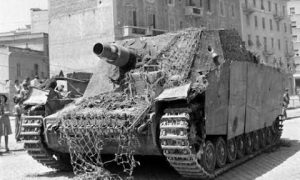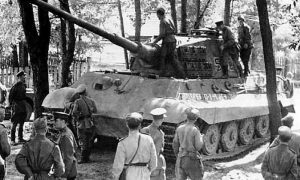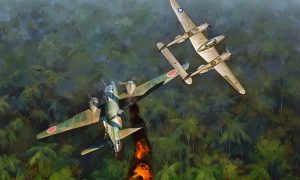Operation Fall Blau – Prelude to Stalingrad – June 28, 1942
Plan “Blau” (German: Fall Blau or Unternehmen Blau – “Blue Option”, “Operation Blau”) (June 28 – November 24, 1942) – part of the strategic plan of Nazi Germany during the summer-autumn German offensive in the southern direction of the East front during the Second World War. The main purpose of the operation was to seize the oil fields of the North Caucasus and Baku.
The summer offensive campaign was planned by the German High Command (OKW) as a chain of successive operations aimed at encircling and quickly defeating at least three Soviet armies on the southern wing of the Eastern Front with access to the Volga and the Caucasus. The operation had four stages and was aimed at destroying the Red Army troops in the southern, southwestern and southeastern directions.
The chain of operations of the Wehrmacht, which began with the “Blau Plan”, ended with a major strategic defeat for Germany and the defeat of the Sixth German Army of Paulus at Stalingrad in early 1943.

Background
Lacking a sufficient number of its own sources of oil, Germany experienced a serious shortage of fuel needed to wage a global war. By the end of 1941, Germany’s domestic oil reserves were practically depleted, with 75% of oil imports coming from Romania. At the end of 1941 Romania warned Hitler that its reserves of already produced oil were exhausted, and the current production could not cover the needs of Germany.
On April 5, 1942, Hitler issued Directive No. 41, setting out plans for military action on the Eastern Front. The directive was codenamed “Plan Blau”. One of the main goals of the plan was to seize the oil fields of the Caucasus and Baku.
As a result of the heavy defeat near Kharkov in May 1942, the defense of the Soviet troops in the zone of the Southern and Southwestern Fronts was drastically weakened. Using this, Hitler decided to launch an offensive in the Caucasus and the Volga. Access to the oil fields of Grozny and Baku was one of the main targets of the German invasion of the USSR. At a meeting at the headquarters of GA “Yug” ( Poltava, June 1, 1942) Hitler said: “If we do not capture Maikop and Grozny, I will have to end the war.” At this stage, Stalingrad was of interest to the Fuhrer only insofar as it was required to destroy the military factories located there and gain a foothold on the Volga. Hitler did not consider the capture of the city necessary.
The leadership of the German Reich had no doubts about the successful outcome of the summer campaign and the final victory. In Germany, in the summer of 1942, the German Oil in the Caucasus joint-stock company was established. Together with the Wehrmacht troops, specialized oil brigades formed in Romania and Germany advanced to Baku and Grozny. The task was set: to ensure the continuity of the operation of the oil fields after their seizure. Together with the oilmen, well pipes for the fields and various pipelines were delivered. In late 1941 – early 1942, protracted battles near Moscow and the Soviet counteroffensive did not allow the German army to quickly reach the Volga, which deprived Germany of hope for a quick “oil feed” for military equipment.
In addition to access to oil, Germany hoped to get the fertile lands of the Don and Kuban. In June 1941, two days before the start of Operation Barbarossa, Rosenberg made a speech, addressing his closest associates, and listed the tasks facing the Wehrmacht. He emphasized that the issue of paramount importance is the provision of food for the German people. The southern territories of Russia were to become the “breadbasket of the people of Germany”.
The Blau plan was based on a swift offensive – blitzkrieg – the defeat of the Red Army and the deprivation of the USSR’s economic power. After the alleged breakthrough and liquidation of the Bryansk Front, the capture of Voronezh and the subsequent turn to the south of mobile German formations along the right bank of the Don, to the rear of the troops of the Southwestern and Southern fronts, was to follow in order to develop further success in the direction of Stalingrad and the Caucasus. The solution to this problem blocked communication between central Russia and the Caucasus. The second stage was the capture of a strategically important city – Rostov-on-Don, the promotion of motorized connections to oil fields -Maykop, Grozny and Baku. In this direction, 37% of infantry, cavalry and 53% of tank and motorized formations were concentrated on the Soviet-German front.

Preparation
A large grouping of Wehrmacht forces was concentrated on the southern wing of the Soviet-German front: three armies and 11 tank divisions were involved. They consisted of five German armies numbering about 1,300,000 people and having 17,000 guns, 1,263 tanks, and support for 1,640 aircraft from the 4th Luftwaffe Air Fleet. In addition to German units, the 8th Italian, 4th Romanian and 2nd Hungarian armies took part.
Tactics
In the offensive, the Wehrmacht used the classic blitzkrieg tactics : breakthroughs with tank wedges with the support of assault aircraft, followed by the destruction or capture of the encircled enemy forces. Air reconnaissance played a significant role. Strategic reconnaissance was carried out by high-altitude reconnaissance aircraft of the ” Rovel group “, tactical reconnaissance – by reconnaissance aircraft Focke-Wulf Fw 189 of the 4th Air Fleet. As a result, the German command had detailed operational information both on the movements of enemy troops and on the construction of fortifications and the placement of strategic objects.
Development of events
Stalin’s mistake
Stalin was confident that the Wehrmacht would deliver the main blow in the direction of Moscow. The commander of the Bryansk front, General FI Golikov, on whose sector the main military operations were supposed to unfold, in the opinion of the Headquarters, was ordered to prepare a plan for a preventive offensive as soon as possible. However, the German offensive began not on Moscow, but on Voronezh and further along two directions – on Rostov and Stalingrad.
Start of the German offensive
The offensive began on June 28. Stalin’s mistake in determining the direction of the main attack greatly facilitated the enemy’s task: without encountering serious resistance, the 4th Panzer Army, with massive aviation support, entered the operational space and rapidly moved towards Voronezh.
Realizing the danger of a German offensive, the Soviet command pulled up the 1st and 16th tank corps (mk) from the 40th army and the 17th mk from the reserve of the Supreme Command Headquarters to the Kastorny area. The order to move to Kastornaya was also received by the 4th and 24th military corps from the Southwestern Front. At this time, the German units advanced deeper and deeper into the gap between the 13th and 40th armies. Tanks of the 24th etc. Wehrmacht broke into the headquarters of the 40th Army, destroying all means of communication. The army command managed to escape, but communication with the army units was lost. The headquarters of the Bryansk Front moved to Kastornaya, from where it was possible to establish contact with some of the tank corps. On June 30, Stalin sent to Kastornaya the commander of the armored forces of the Red Army, Ya. N. Fedorenko, to direct the tank corps. In daily (night) communications, Stalin reminded the commander of the Bryansk front, FI Golikov, that he had more than a thousand tanks at his disposal and demanded that they be “ used humanly ”. However, it was not possible to assemble the hulls into a single fist. On June 30, the tank units of the Wehrmacht broke through the front of the 21st Army and moved to Novy Oskol.
The fall of Voronezh
On July 2, the Stavka ordered the commander of the Bryansk Front, Golikov, to personally arrive in Voronezh. At his disposal were two reserve armies: the 6th and 60th. Golikov deployed armies to the north and south of Voronezh in the direction of retreat of the 4th, 17th and 24th Panzer Corps. Reinforcements were deployed to the Voronezh area to close the 50-kilometer gap between the Bryansk and Southwestern fronts. So, the 5th Panzer Army, located in Yelets, received an order to advance to Voronezh and strike from the north into the flank of the advancing enemy forces.

On July 3, the 24th Panzer Division of the Wehrmacht crossed the Don in the Voronezh region; the next day, the SS division “Great Germany” captured the Don crossings in the city. By July 6, the Germans occupied most of Voronezh. The fall of Voronezh caused great alarm at Headquarters: Stalin constantly demanded from Vasilevsky reports on what was happening. On July 5, Vasilevsky hastily issued an order to bring into battle the 5th Tank Army (comm. – Major General A.I. Lizyukov ), despite the fact that some of the army’s tank corps were still on their way from Yelets… The poorly prepared offensive of the 5th Panzer Army ended in disaster: the army was defeated in parts, General AI Lizyukov was killed.
According to Major General Friedrich von Mellentin, the unsuccessful actions of the Soviet tank forces near Voronezh were due to the lack of proper intelligence and communications:
In a tank battle near Gorodishche, just in the middle between Kursk and Voronezh, the advanced tank units of the Russians were met by the anti-tank artillery of the tank corps and then destroyed by our tanks, which attacked the enemy from the flank and from the rear. Since our commanders had the opportunity to timely “look” into the enemy’s location and find out what he was preparing, they could organize ambushes and repel one after another enemy counterattacks.

Historians’ estimates
The preparation and course of Operation Blau is described in detail in the works of British (British) and American historians. British military historian and theorist BG Liddell Hart notes that Hitler’s decision on the summer offensive of 1942 was significantly influenced by the message of his economic advisers that the course of the war would be significantly hampered if the troops did not receive Caucasian oil, ore and wheat. Another prominent English historian D. Fuller pointed out that, unlike the 1941 offensive according to the Barbarossa plan, the second general phased offensive was aimed at striking the material basis of the Soviet army and depriving the country of economic power.
The famous British historian E. Beevor in his book “Stalingrad” argues that the main blow in the operation “Siegfried”, later renamed “Blau”, Hitler intended to inflict “in the south of Russia” and did not doubt the success of the proposed campaign. The English scientist M. Howard emphasized that the Germans were forced to postpone the start of the main offensive to the end of July, not only because of bad weather, but also because their plans were prevented by the stubborn resistance of the Soviet troops.
Since the course of battles in 1941-1943 was more often defensive in nature, the topic was poorly studied by Soviet historians. In the late XX – early XXI century, it was developed in regional studies, based on documents from the period of the Great Patriotic War. The fighting in the southern direction in the summer of 1942 attracted the attention of both regional historians] and their Western colleagues such as Robert Sitino (USA), John Erickson (Great Britain) and others.
Tactical mistakes
Historians agree that the plans for the offensive were known to the Soviet command (Fuller, Howard, etc) From archival documents it follows that in early July, when the mobile troops of the Wehrmacht reached the Don, only one unit defended the approaches to Voronezh – the 232nd Infantry Division under the command of Lieutenant Colonel I.I. Ulitin, which did not have engineering structures suitable for defense bunkers and trenches (the compiled act is indicated in the archival inventory of the TsAMO RF). 152nd Infantry Division was able to occupy defensive lines on the right only on July 5.
According to the British military historian Major General D. Fuller, the plan for Operation Blau was not implemented due to underestimation of the strength and moral staunchness of the Russian army. He also noted that along with the increase in the firepower of the German army, its morale was reduced. Numerous attempts to justify the failure of the summer-autumn offensive of the German troops superior enemy forces also have no basis.
The Soviet and Russian historian A.I.Utkin believes that the strike force of Germany in 1942, concentrated on the southern sector of the front at the insistence of Hitler by Manstein, became the reason for the failure of the entire operation. Several weeks, during which there were battles in Kerch, Crimea and the defense of Sevastopol, the fascist armies detained and decided the outcome of the battle at Stalingrad… Perhaps Hitler was mistaken when he set a condition for the offensive actions of 1942: to clear the Crimean peninsula of Soviet bridgeheads – the Kerch and Sevastopol units. Assuming that the Crimea, Soviet troops can strike at the flank of the Wehrmacht troops, he could not foresee the heroic defense of Sevastopol, which resulted in a significant delay in the onset and took away a few critical weeks. The losses of the fascists in the Crimea were also significant.
According to historian William Craig, the Wehrmacht generals did not raise any objections to his proposed operational plan for the summer offensive, code-named Blau, which completely ignored the logistical problems associated with long supply lines: the Germans lack of manpower and equipment for such a large-scale campaign; although the troops were outnumbered and were equipped with equipment, the main emphasis in the offensive was placed on the “catastrophic position” of the enemy.
It should also be noted the widespread negative attitude of the population towards the occupation policy of the Nazis in the occupied territories, as a result of which the partisan movement grew and expanded, as well as the lack of combat experience gained by German troops during the war in Europe, a decrease in morale in German troops: instead of a quick victory, soldiers were forced to endure hardships in the harsh Russian winter, fighting with a fierce enemy.
After the capture of Rostov-on-Don by the German army, Hitler considered the result of the Blau plan achieved.
Analysis of the measures taken by the Supreme Commander-in-Chief of Western historians is unequivocally noted as a mistake (historian E. Beevor, independent English journalist, consultant on military history issues E. Gilbert, director of the Center for the Study of Military Conflicts of the Royal Military Academy of Great Britain D. Anderson, senior lecturers of the Royal Military Academy of Great Britain L. Clarkeand S. Walsh, professor of history at the University of Mississippi, USA, and others), since he assumed that the attack on Voronezh was a preparation for a further attack on Moscow. This opinion is confirmed in the memoirs of the prominent Soviet military leader Marshal of the Soviet Union A.M. Vasilevsky, who was chief of the General Staff of the Red Army during the war years, and most of the front commanders of the military leaders agreed with him. This was also noted by the head of the Operations Directorate of the General Staff, S. M. Shtemenko, who emphasized that in the presence of different points of view about the summer offensive of the Germans, Stalin preferred a general attack on Moscow.

Outcome
As a result of the breakthrough of the 4th TA of the Wehrmacht, at the junction of the Bryansk and Southwestern fronts, a gap was formed about 200 km along the front and 150 – in depth. At the same time, Paulus’ 6th Army reached Ostrogozhsk south of Voronezh and threatened to attack into the rear of the Southwestern and Southern Fronts.
Actions of the VGK rate
By the time Operation Blau began during the unsuccessful spring offensive against Kharkov, most of the Soviet Southern Front had been surrounded and practically destroyed. The troops were retreating: the commanders and soldiers had no combat experience; the army lacked the interaction of all types of troops – artillery, aviation, tankers, infantry; the troops suffered heavy losses in manpower and equipment. Stalin, Vasilevsky and other members of the Supreme Command Headquarters realized the real purpose of the Blau plan and began hastily to take protective measures: On July 7, the Voronezh Front was created (commander – NF Vatutin ), for which troops were transferred from the central sector of the front… The troops of the Southwestern Front received permission to retreat from the Donets to the Don, which allowed them to avoid encirclement. On July 12, the Stalingrad Front was created. In addition to the remnants of the Southwestern Front, it included three reserve armies: the 62nd (commander – Major General V. Ya. Kolpakchi ), 63rd (commander – Major General V.I.Kuznetsov ) and 64th (commander – Major General V. N. Gordov ). At the same time, Stalin suggested starting diversionary actions in the central and northern sectors of the front in order to tie up the enemy’s reserves there. By the end of July, four armies of Kalininskyand the Western Fronts launched an offensive in the Rzhev area.
Actions of Hitler and the Wehrmacht
During the offensive, the 2nd and 4th tank divisions of the Wehrmacht were tasked with creating a wedge on the outer flanks, quickly moving forward, encircling the enemy troops and destroying them. Foreign historians recognized, albeit in passing, the merits of the Soviet military command, which did not allow troops to be drawn into protracted battles, and thus they avoided encirclement. German generals also recognized this fact: the former major general of the Wehrmacht B. Müller-Hillebrandt wrote in his memoirs that the Russians on the southern sector of the front did not engage in battle, trying to stop the offensive, but withdrew with battles.
On July 10, German troops captured the eastern bank of the Don and the right bank of the city of Voronezh; on July 2, the Nazis completely occupied the Kursk region. However, a quick and complete capture of Voronezh was avoided. Soviet troops were entrenched on the left bank of the Don and the forces of the Voronezh Front tried to conduct active offensive operations. Fighting took place on the outskirts of the city, numerous attempts were made to liberate the right bank. Thus, the 2nd German army and the 3rd Hungarian corps (10-15 divisions) were pinned down in the Voronezh region and could not conduct a full-fledged offensive.
On July 13, Hitler abandoned the immediate capture of Stalingrad and turned his attention to the Caucasus. Planning to encircle and destroy the forces of the Southern Front in the lower reaches of the Don, he ordered the 4th TA to stop the attack on Stalingrad and move south to join the 1st TA and 17th Army, which were advancing on Rostov-on-Don. The 40th Panzer Corps from GA Yug was also sent there. 6th Army Paulus had to continue to move to the Volga without the support of tank forces.
On June 30, 1942, the German command renamed the Blau plan to the Braunschweig plan, the task of which was to strike through the Western Caucasus and further along the Black Sea coast to the Batumi region. After the fall of Rostov-on-Don, Hitler considered the result of the Blau plan achieved and on July 23, 1942 issued directive No. 45 on the continuation of Operation Braunschweig.
The Blau plan stipulated that the offensive should take place on the entire German front in the southern part of Russia – from Taganrog along the Donets River and then unfold in the direction of Kharkov and Kursk. In the second echelon, it was supposed to enter the forces of the infantry armies. However, the operation in the Caucasus did not bring success – the Southern Front was attacked by the Red Army. Despite the large territories captured by the Germans, the offensive required too much effort. The plan was carried out at the cost of heavy losses: the Soviet troops changed the tactics of warfare – they skillfully maneuvered, defended or went on the offensive… Despite the fact that the tank columns moved forward, in general, the Wehrmacht failed to encircle and destroy, according to the Blau plan, not a single large military unit of the Red Army. Further development of Blau’s plan led the Wehrmacht troops to defeat in Stalingrad.





















Pingback: Soviet Evacuation of Factories, People and Industries. - Real History Online
Pingback: 28 Juin 1942 – Début de l'opération Fall Blau de la Wehrmacht en URSS - Nima REJA